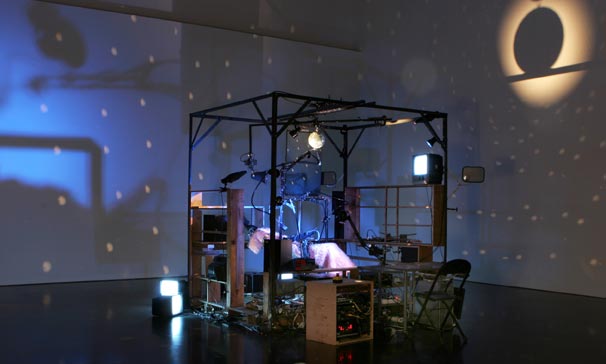Shaun Gladwell
·
Shaun Gladwell: Stereo Sequences Exhibition
Catalogue (Victoria: Australian Centre for the Moving Image, Schwartz City)
This
exhibition catalogue of the Stereo Sequence Exhibition shown at ACMI was very
important in my research. Not only did it display a wide variety of film stills
of Gladwell’s work, but it also had relevant essays by Sarah Tutton, Rex Butler
and Adrian Martin. Tutton’s essay goes
into detail on a selection of Gadwell’s works and explains them well. As it is hard to find the full video works
online to view for most of Gladwell’s films, it is valuable to get a thorough
description of the works. I found that
this publication allowed me to increase my understanding of the works and their
installation at ACMI in more detail.
Butler’s Essay was helpful in providing an insight into the works
created in Afghanistan which were hard to find specific info on. The other crucial part of the catalogue was
the extensive list of video stills along with all the info such as type of
video, performers, sound, how it was displayed and when it was made.
·
Blair French, “Return to Earth,” in Shaun Gladwell: Videowork, (Sydney:
Artspace Visual Arts Centre, 2007)
I found
Blair French’s essay on Gladwell’s work very useful, mainly due to the
comprehensive explanation of themes that Gladwell explores in his work. Themes such as gravity, place and status are
discussed along with Gladwell’s background in painting. The discussion on how his painting background
affects and shows itself within his video work, through his framing and choice
of perspective and shots, I found noteworthy as it was something I had never considered
in terms of mark making and painting within video and film space. French’s essay also helped me understand Chrissie
Iles’ Video and Film Space essay in more depth.
·
“Australian Story: War Paint,” ABC1 Monday
September 3, 2012, also online http://www.abc.net.au/iview/#/view/998528
Even
though this Australian Story was specifically about Ben Quilty it gave me a
better background understanding into the duties and position of being a war
artist. Gladwell’s work in Afghanistan, I found, was the most difficult out of
all his artworks to get information on. This Australian Story gave me an idea
about what is involved in being a war artist and what exactly the Australian
War Memorial commissions artist to do. The
interviews with the troops were particularly insightful and the preconceptions
they have about the war artists and the subsequent relationships they form are
very interesting. Overall I think the
most important thing I became aware of from watching the program was the
emotional intensity that is connected with being a war artist.
Sally
Breen, “Remixes for a new[ish] millennium,” in Shaun Gladwell New Balance Exhibition Catalogue, (Perth: Perth
Institute of Contemporary Arts, 2004)
Igor
Holubizky, “Shaun Gladwell: Beating a path, an enactment,” in MMXBreakless Sessions Exhibition Catalogue,
(Paddington: Sherman Galleries, 2005)
Chrissie
Iles, “Video and Film Space,” in Space,
Site and Intervention: Situating Installation Art, trans. Erika Suderburg (Minneapolis: University of Minnesota
Press, 2000): 252-62
Daniel
Baumann, “Shaun Gladwell: Public space, translation and beauty,” Art
&Australia 44 No.4 (2007): 570-575.
Elizabeth
Fortescue, “Shaun Gladwell on life in Afghanistan,” The Art Newspaper, January
13, 2010, accessed August 20, 2012, http://www.theartnewspaper.com/articles/Shaun-Gladwell-on-life-in-Afghanistan/20001
Reuben Keehan, “Shaun Gladwell’s moving pictures,” Art &Australia 45 No.4
(2008):650.
John Kelly, "The Beauty of Distance," Art Monthly Australia 221 (2009):10-13.
Steve Meacham, “Catching a creative wave,” The Age October 8, 2011, accessed August 20, 2012, http://www.theage.com.au/entertainment/art-and-design/catching-a-creative-wave-20111006-1la3t.html
Joanna
Mendelssohn, “Shaun Gladwell,” Artlink 23 no 3
(2003), accessed August 9, 2012, http://www.artlink.com.au/articles.cfm?id=2334
Daniel Palmer, “Shaun Gladwell,”
Frieze 114, April (2008), accessed August 8, 2012,
http://www.frieze.com/issue/review/shaun_gladwell/
Michael
Young, “Shaun Gladwell – Riding with Death: Redux,” Art Asia Pacific Online,
accessed August 20, 2012, http://artasiapacific.com/Magazine/WebExclusives/RidingWithDeathReduxShaunGladwell
“Shaun
Gladwell,” Anna Schwartz Gallery, accessed August 22, 2012,
http://www.annaschwartzgallery.com/works/works?artist=86&c=s
“Shaun
Gladwell– Afghanistan,” Australian War Memorial, accessed September 1, 2012,
https://www.awm.gov.au/exhibitions/gladwell/
“Shaun
Gladwell,” Australian Centre for the Moving Image, accessed August 8, 2012, http://www.acmi.net.au/shaun-gladwell.aspx
“Josh Raymond Projects,” Josh Raymond,
accessed August 20, 2012, http://www.joshraymond.com/projects/
“Shaun
Gladwell: Move Video in Schools,” Kaldor Public Arts Projects, accessed August
20, 2012, http://kaldorartprojects.org.au/move-artists/shaun-gladwell
Penny Craswell, “PROFILE: SHAUN GLADWELL,” accessed
August 8, 2012, http://www.experimenta.org/mesh/mesh17/gladwell.htm
“Art
Nation - Shaun Gladwell,” ABC Arts Online, Last modified April
23, 2010, http://www.abc.net.au/arts/stories/s2881260.htm
“Shaun Gladwell:
Stereo Sequences Interviews,” ACMI online, last modified June 6, 2011, http://www.youtube.com/watch?v=ataRzGlLlsw
“Shaun
Gladwell,” DasPlatforms, last modified November 27, 2011, http://www.youtube.com/watch?v=2MeOguswrc0&feature=related
Interceptor Surf Sequence (Exit), 2009
2-channel, HD video,16:9, silent
27:42 minutes



,+2009.jpg)
